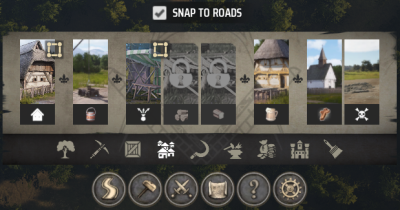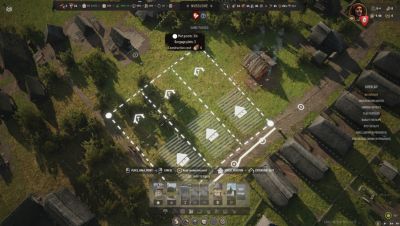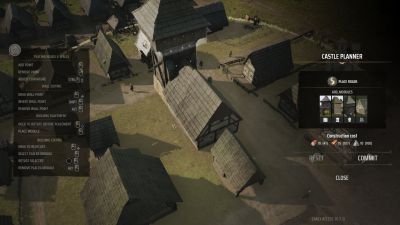⚠ NOTICE
The game has been released in Early Access on 26th of April, 2024.
Please keep in mind that any information provided on this Wiki may be incomplete or subject to change as the game progresses.
Edifici
La costruzione può essere effettuata solo da famiglie non assegnate ad alcun lavoro. Inoltre, è necessario almeno un bue se l'edificio richiede legname.
Alcuni edifici hanno bordi flessibili, identificati con un quadrato di confine nel menu di costruzione. Per questi edifici, è necessario posizionare 4 punti per designare un'area. I primi due punti segnano la facciata dell'edificio. Anche se le linee sono rettilinee, si curvano lungo le strade.
Una volta posizionato, ogni edificio può avere una priorità di costruzione diversa, selezionabile, se deve essere costruito prima o dopo altri edifici.
Molti edifici possono essere aggiornati per aumentarne la funzionalità. Alcuni aggiornamenti richiedono un determinato ramo di sviluppo.
Tutti gli edifici possono essere demoliti, con conseguente rimborso di tutte le risorse di costruzione.
Strade
Alcuni edifici consentono agli abitanti del villaggio di utilizzare i carretti a mano per trasportare fino a 10 merci contemporaneamente. Tuttavia, il traino di un carretto fuori strada è estremamente lento, quindi assicurati di collegare gli edifici alle strade.
Ogni mappa inizia con una strada esistente chiamata Strada del Re. Questa strada non può essere rimossa e le postazioni commerciali devono essere collegate ad essa per attirare i mercanti in viaggio.
Gli edifici si agganciano automaticamente alle strade. Questo comportamento può essere disabilitato nel menu di costruzione.
Campo dei coloni
Ogni regione inizierà con un campo dei coloni. Scompariranno quando tutte le famiglie saranno sistemate in delle abitazioni. In alternativa, per 1 legname, possono essere trasformate in un campo di lavoratori che fornirà 5 spazi abitativi.
Raccolta e Produzioni degli edifici
| Costruzione | Costo | Effetti | Luoghi di lavoro | Stoccaggio | Ramo di sviluppo | Trasferimento |
|---|---|---|---|---|---|---|
| Segheria | 2 legname | Trasforma gli alberi in legname. | 3 | 28 legname | ||
| Rifugio del boscaiolo | 1 legname | Trasforma gli alberi in legna da ardere. | 3 | 50 legna da ardere | ||
| Buca del segantino | 2 legname | Trasforma il legname in assi. Può impostare una riserva di costruzione di legname, il che significa che l'edificio funzionerà solo se la quantità immagazzinata è maggiore. |
2 | 50 assi | ||
| [[Special:MyLanguage/Capanno del guardaboschi|Capanno del guardaboschi] | 2 timber | Plants trees. | 2 | | ||
| Charcoal kiln | 2 timber | Turns 1 firewood into 2 charcoal. | 3 | 50 charcoal | Charcoal burning |
|
| Hunting camp | Turns wild animals into meat and hides. Can set a hunting limit, meaning the building will only work if the animal number is greater. |
2 | 12 Hides 36 Meat |
| ||
| Forager hut | 1 timber | Gathers berries from nearby berry deposits. Can be upgraded with a herb garden for 2 planks and 25 regional wealth, allowing it to produce herbs. |
4 | 50 Berries | | |
| Apiary | 2 planks | Produces honey. Every region can sustain up to 2 apiaries by default. Placing more will not increase the yields. |
4 | 5 honey | Beekeeping |
|
Mining buildings
Mining buildings must be constructed near resource deposits. Each one can employ up to 4 families and store up to 50 resources.
With the Deep mining development branch the Mining pit can be upgraded to a Deep mine if it is placed over a Rich deposit at the cost of 10 Planks and 50 Regional Wealth. This will allow it to produce resources indefinitely.
| Building | Cost | Produces | Required deposit | Relocation |
|---|---|---|---|---|
| Stonecutter camp | 2 Timber | Stone | Fieldstone deposit | |
| Mining pit | 1 Timber | Iron Ore | Iron deposit |
|
| Clay | Clay deposit |
Logistics buildings
| Building | Cost | Effects | Workplaces | Relocation |
|---|---|---|---|---|
| Granary | 2 Timber 10 Stone |
Stores up to 500 food resources or Ale. Workers collect, store and distribute goods using the Pantry. If needed, they will also automatically set up stalls on the marketplace to distribute the stored goods to Burgage plots. Can be upgraded to Large granary for 5 Timber, 10 Planks and 5 Stone, which increases the resources capacity to 2500. |
5 |
|
| Storehouse | 2 Timber | Stores up to 250 non-food resources. Workers collect, store and distribute goods using Generic storage. If needed, they will also automatically set up stalls on the marketplace to distribute the stored goods to Burgage plots. Can manually restrict what resources are stored inside. Protects resources from weather if weather events are enabled. Can be upgraded to a Large Storehouse for 5 Timber and 10 Planks, which increases the resources capacity to 2500. |
2 |
|
| Pack station | 1 Timber | Can choose 1 resource to send and 1 resource to receive from another owned region. Employ Mules to transport up to 20 goods per trip. Provides 2 Stable Space. Can order mules. |
1 |
|
| Hitching post | 1 Timber | Provides 1 Stable Space. Assigned families become permanent Ox Guides, which speeds up logistics. Can order horses or oxen. Can be upgraded to Small stable for 2 Planks to increase Stable space by 1. |
2 |
Residential buildings
Marketplaces should be placed close to Burgage plots and storage buildings to maximize their efficiency. The placement of other buildings does not matter and one is sufficient for the entire region.
| Building | Cost | Effects | Relocation | Development branch |
|---|---|---|---|---|
| Well | 1 Timber | Provides Drinking water to Burgage plots. Enables Firefighting. If well placement in game settings was set to unconstrained it can be built anywhere. If well placement in game settings was set to underground water it requires underground water. |
|
|
| Marketplace | Provides space for families to set up stalls and distribute their produce to the Burgage plots. A healthy supply and demand ratio of goods is needed to fulfill Residential requirements and keep Approval high. Each stall can store 50 resources. |
|
||
| Firewood cart | Turns 1 Regional wealth into 1 Firewood. Can store 15 Firewood. Region does not pay the Transport fee. Must be placed in the Marketplace. |
Foreign suppliers | ||
| Food cart | Turns 4 Regional wealth into 1 Bread. Can store 15 Bread. Region does not pay the Transport fee. Must be placed in the Marketplace. |
Foreign Suppliers | ||
| Tavern | 5 Timber | Fulfills 1 level of Entertainment requirement for the Burgage plots. Needs Ale to function. Can store 100 Ale. |
|
|
| Wooden church | 5 Timber 20 planks 10 Stone |
Fulfills the Faith requirement equal to its level for the Burgage plots. Provides Hallowed ground for Burial of the dead villagers. Workers become Gravediggers. Church bell sound effect can be changed at any point. Can be upgraded to Small stone church for 5 Timber, 20 Stone, 10 Planks and 10 Roof tiles to satisfy level 2 needs. |
|
|
| Corpse pit | Not all deserve to be buried on consecrated ground. Use this building to get rid of any raider corpses quickly. Workers become Gravediggers. |
|
Burgage plots
- Main article: Special:MyLanguage/Burgage plot .
Burgage plots are the primary buildings in Manor Lords. They are flexible plots, costing 2 Timber for each building that fits on the plot. Each Burgage plot provides 1 Living space. If they have some space sideways but not sufficient for another Burgage plots then they can be expanded to grant another 1 Living Space at the cost of 2 Timber. New families will only join if there is unused Living space and Approval is high enough. Burgage plots cannot be moved. Burgage plots start at level 1.
- Upgrading them to level 2 requires the Small village settlement level, costs 4 Timber and will generate 1 Regional wealth per family per month.
- Upgrading them to level 3 requires the Medium village settlement level, costs 4 Timber, 8 Planks, 4 Roof tiles and 25 Regional wealth and will generate 2 Regional wealth per family per month. It also increases Living space by 1, or 2 for expanded buildings.
Farming buildings
Farming buildings cannot be relocated.
| Building | Cost | Effects | Workplaces | Storage |
|---|---|---|---|---|
| Field | Space to grow Wheat, Barley, Flax, or Fallow. To employ peasants on the fields, you need to build a Farmhouse. Larger fields are more effective but also take longer to plow by hand. All crops reduce Fertility, which can be combated by rotating crops or growing Fallow for a year. Resources are collected in September. All fields can be given a priority, which determines they order they are worked on. With the Fertilization development branch it can be upgraded with a fence for 5 Planks, which improves Fallow crop. |
|||
| Farmhouse | 3 Timber | Used to employ families on the Field. Farm workers plow the fields as soon as the Winter passes, but no later than November. Then they sow them. Harvest happens around September. Then the crops are transported to the Farmhouse, and Wheat is turned to Grain. Can store up to 1200 resources. With the Heavy Plow development branch it can be upgraded with a plowing station for 1 Timber, which allows oxen to work here. |
8 | 1200 Crops |
| Pasture | Provides Pasture space. | |||
| Sheep farm | 1 Timber | Collects Wool from grazing Sheep. Sheep must first be imported via the Livestock trader. Provides 5 Pasture space. |
3 | 50 Wool |
| Windmill | 4 Timber | Turns Grain into Flour. Efficiency increases with distance from trees and buildings. |
3 | 250 Flour |
| Communal oven | 2 Timber | Turns Flour into Bread. | 3 | 50 Bread |
Industry buildings
Industry buildings refine resources. All of them can store 50 resources with the exception of the Clay furnace which can store 250. Industry buildings cannot be relocated.
| Building | Cost | Requires | Produces | Workplaces | Needs fuel |
|---|---|---|---|---|---|
| Bloomery | 2 Timber | Iron ore | Iron slabs | 2 | |
| Smithy | 2 Timber | Iron slabs | Tools | 2 | |
| Clay furnace | 2 Timber 5 Stone |
Clay | Roof tiles | 5 | |
| Malthouse | 4 Timber | Barley | Malt | 2 | |
| Tannery | 4 Timber | Hides | Leather | 3 |
|
| Weaver workshop | 4 Timber | Wool | Yarn | 3 |
|
| Flax | Linen | ||||
| Dyer's workshop | 2 Timber | Berries | Dyes | 4 |
|
Trade buildings
Trade buildings can be set to export and import with other regions in exchange for Regional wealth. They cannot be relocated.
| Building | Cost | Trades | Notes | Workplaces |
|---|---|---|---|---|
| Trading post | 4 Timber | Resources | 1 family member travels to the nearest possible destination to conduct trade while rest manage the inventory If needed, assigned families will automatically set up stalls on the marketplace to sell imported goods. Can store 500 resources Can order horses |
4 |
| Livestock trading post | 2 Timber | Animals | Provides 4 Pasture space Provides 2 Stable space |
3 |
Administration buildings
Administration buildings cannot be relocated and fulfills special gameplay needs.
- Settlers camp can only be placed in regions that has been claimed but has no buildings. It needs at least 250 Treasury to be placed and once placed you can choose to pay 250, 500 or 750 Treasury to determine that starting resources in the new region. Once placed it will immediately be converted into a Homeless people's tents.
- Manor costs 5 Timber, 20 Planks and 25 Stone. Once constructed it grants 250 Influence, rises the Administration level by 1 and enables taxing people. It requires Fuel resources. Only one Manor can be constructed per region. After building the first Manor the Retinue will be recruited. Manors have an area around them where they can be upgraded with various modules:
- Walls cost 2 Planks per segment. If they cross a road it will create a Gate that costs 2 Timber.
- Outer towers cost 10 Timber and 5 Stone each and provides 10 Garrison space.
- The garrison tower costs 10 Timber, 15 Planks and 10 Stone and increases maximum Retinue size by 12. Only one can be constructed.
- Tax offices cost 4 Timber. At present, this building is purely cosmetic; it is undergoing a rework.
 Hooded Horse Wikis
Hooded Horse Wikis



